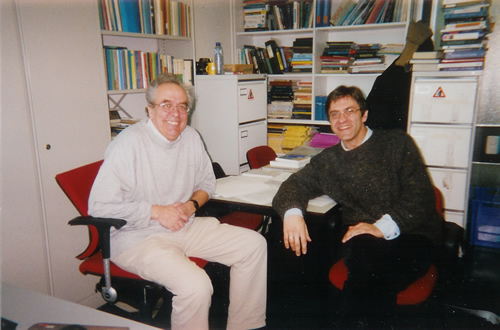
Restrictions addilog EI 2006-11
Income elasticities and CGE EI 2006-12

In this paper Marco Missaglia (right) and I analyze the provision of emergency assistance (food assistance, cash transfers, employment programs, etc.) to a country whose economy has been decimated since the start of the second intifada. We try to simulate the different potential effects brought about by these different policies and, especially, to draw some policy implications concerning the Food-for-Work versus Cash-for-Work debate.
To that end we have constructed a general equilibrium model of the Palestinian economy that we calibrate on the (pre-intifada) Social Accounting Matrix (SAM) of 1998. We give a so-called "intifada-shock" to construct a counterfactual "post-intifada" SAM which serves as basis for our policy simulations.
We show that monetary aid from abroad is to be preferred to food aid from abroad. We argue that a labor-oriented approach (subsidizing the most labor-intensive sectors) is to be preferred to a welfare-oriented approach where the subsidized sectors produce those goods that dominate the consumption basket.
Second European Conference of the Middle East Economic Association, Paris, June 2003
Sixth Annual Conference on Global Economic Analysis, Scheveningen, June 2003
EcoMod 2003, Istanbul, July 2003
Sixth International Conference on the Economics and Finance in the Middle
East and North Africa, Lebanese American University, Byblos, Libanon, May 2004
and has been published in:
Economic Systems Research, 16, 2004, pp. 367-390.
![]() Food-For-Work versus Cash-For-Work:
Emergency Assistance in Palestine
Food-For-Work versus Cash-For-Work:
Emergency Assistance in Palestine
The most recent years of the Palestinian history, those of the second intifada, have witnessed a dramatic decline in all Palestinian economic and social indicators. Since September 2000, when the violent confrontations started, conditions for a normal life have nearly disappeared and the economic situation has steadily disintegrated.
Using a poverty line of US$ 2.1 per day the World Bank estimated the poverty in Palestine in 1998 at 23.2% of the population, whereas by the end of 2002 the Bank estimated the poverty to have risen to 59 percent. The unemployment rate that amounted to 16.2% in 1998 rose to 37% at the end of 2002. The overall GNI losses have reached US$ 5.2 billion during the first twenty-seven months of intifada, which is more than the GNI in 1998 or in 1999 (US$ 5.1 billion).
Two main causes of the Palestinian economic crisis are closure, namely the imposition of restrictions on the movement of goods and people across borders and within Palestine, and the destruction of capital. The Bank estimated the number of Palestinians working in Israel and the settlements at 128,000 in September 2000, while the estimate for end 2002 was about 32,000. The physical damage resulting from the conflict was estimated to be US$ 305 million by the end of 2001 and US$ 930 million by the end of 2002. As a result of damage and of the fall in investment, the real productive capital stock declined by US$ 1.7 billion between 1999 and 2002.
It is clear that an already fragile economy has been hit very hard by the conflict.
However, there is no consensus on the extent and the order of magnitude by which the Palestinian economy has suffered during the last years of conflict.
The evaluations coming from the World Bank (World Bank 2003a, 2003b and 2003c) are substantially different from those of the International Monetary Fund (IMF, 2003).
This is the reason why in this paper we try to propose our own evaluation of the economic consequences of the conflict, with the help of a computable general equilibrium (CGE) model.
Sixth International Conference on the Economics and Finance in the Middle
East and North Africa, Lebanese American University, Byblos, Libanon, May 2004
and has been published in:
Economic Systems Research, 18, 2006, pp. 498-505.
![]() Economic consequences of intifada
Economic consequences of intifada
Economic consequences of intifada: a sequel
In January 2006 Hamas won the elections and the Palestinian Authority (PA) government, led by Hamas, was confronted with diplomatic and financial isolation by the international community, with internal tensions and with tensions with Israel. It resulted in decline of the Palestinian economy.
In March 2007, IMF and World Bank (IMF&WB (2007)) published a first assessment of the economic developments in 2006 of the economy of Palestine and provided the consensus estimates of the macro economic figures using data that are more up-to-date and more complete than the data IMF disposed of in 2003.
The second intifada started on 20 September 2000 and it follows from table 2 of IMF&WB (2007) that the Palestinian economy, measured by the real gross national income, declined until 2003; whereas it experienced a recovery in 2003-2005. Consequently, from the economic point of view the second intifada runs from 20 September 2000 to ultimo 2002, the period of twenty-seven months that we studied in our previous two papers.
IMF&WB also give an estimate of the nominal GNI of 2000, 2001 and 2002. Its sum amounts to 13,013 million US$. We base our “growth scenario” of GNI on footnote 7 of IMF&WB (2007) which reads: “If the Palestinian economy had grown at a steady, but modest 3 percent each year since 1999, with a 3 percent annual GDP deflator, nominal GDP would have been more than $2 billion higher in 2006”. According to this scenario the sum over 2000-2002 amounts to 18,437 million US$. The difference, 5,424 million US$, is our assessment of the economic consequences of intifada. This amount is equivalent to the 1999 GNI of 5,454 million US$. It is as if the Palestinian economy completely stopped working, did not receive any development aid or financial support from relatives living abroad, for one year out of two years and a quarter.